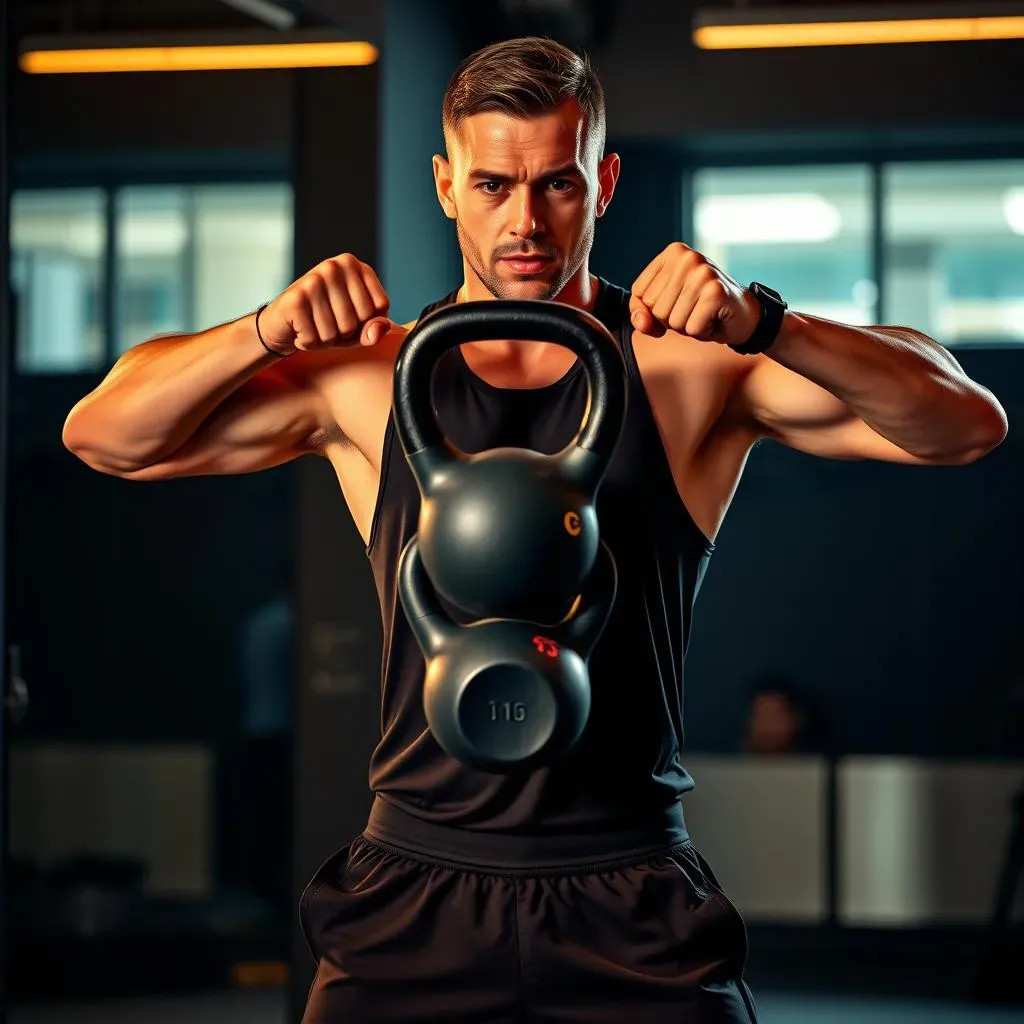Table of Contents
Want shoulders that not only look great but also function like a well-oiled machine? Then you've landed in the right spot. Forget endless hours with dumbbells; we're diving headfirst into the world of kettlebell shoulder workouts. Kettlebells offer a unique way to challenge your shoulder muscles, improving strength, stability, and overall mobility. This isn't just about aesthetics; it's about building resilient shoulders that can handle whatever life throws your way.
WarmUp Essentials for Kettlebell Shoulder Workouts

WarmUp Essentials for Kettlebell Shoulder Workouts
Why Warm-Up Matters for Kettlebell Training
Alright, before you even think about picking up that kettlebell, let's talk warm-ups. I know, I know, it's tempting to jump right into the action, especially when you're short on time. But trust me on this one: skipping the warm-up is like driving a car with cold engine oil – you're just asking for trouble. When it comes to kettlebell shoulder workouts, a proper warm-up is absolutely crucial for preventing injuries and maximizing performance. Think of it as prepping your shoulders for battle. We're not just swinging weight; we're engaging a complex network of muscles, tendons, and ligaments. A good warm-up increases blood flow, improves joint mobility, and activates the muscles you'll be using, setting the stage for a safe and effective workout.
Have you ever felt that twinge in your shoulder during a workout and thought, "Oh, I'll just push through it"? Yeah, that's your body screaming for help. Don't ignore it! A few minutes of targeted warm-up exercises can make all the difference between a killer workout and a trip to the physical therapist. Plus, a good warm-up isn't just about injury prevention; it also improves your range of motion and coordination, allowing you to perform kettlebell exercises with better form and control. So, ditch the excuses and make warm-ups a non-negotiable part of your routine.
- Increased Blood Flow: Warmer muscles are more pliable and less prone to injury.
- Improved Joint Mobility: Allows for a greater range of motion during exercises.
- Muscle Activation: Prepares the specific muscles you'll be using in your workout.
- Enhanced Performance: Better range of motion and muscle activation lead to more effective workouts.
The Ultimate Kettlebell Shoulder Warm-Up Routine
so now that we're on the same page about the importance of warm-ups, let's get down to the nitty-gritty. What does a truly effective warm-up for kettlebell shoulder workouts actually look like? It's not just about flailing your arms around for a few minutes; it's about targeting the specific muscles and joints that will be under stress during your workout. We're talking about dynamic stretches, mobility drills, and light activation exercises that will get your shoulders firing on all cylinders. Think arm circles, shoulder rotations, scapular retractions, and light kettlebell movements like halos and pass-throughs. The goal is to gradually increase your heart rate, loosen up your joints, and prime your muscles for the work ahead.
Here's a sample routine to get you started: Start with 5 minutes of light cardio, like jumping jacks or high knees, to get your blood flowing. Then, move into these specific shoulder mobility and activation exercises:
- Arm Circles: 10 forward, 10 backward.
- Shoulder Rotations: 10 internal, 10 external.
- Scapular Retractions: 15 reps, focusing on squeezing your shoulder blades together.
- Kettlebell Halos: 5 reps in each direction, using a light kettlebell.
- Kettlebell Pass-Throughs: 10 reps, maintaining a straight arm and good posture.
Essential Kettlebell Exercises for Boulder Shoulders

Essential Kettlebell Exercises for Boulder Shoulders
The Kettlebell Swing: Your Foundation for Shoulder Strength
Alright, let's get into the good stuff: the exercises that will actually build those boulder shoulders you're after. And where better to start than with the king of all kettlebell exercises: the swing? Now, I know what you're thinking: "The swing? That's a lower body exercise!" And you're not entirely wrong. But the kettlebell swing, when done correctly, is a fantastic way to build shoulder stability and power, which are essential for all other kettlebell shoulder workouts. The swing teaches you how to properly engage your lats and core, creating a solid foundation for your shoulder girdle to work from. Think of it as the base upon which you'll build your shoulder strength masterpiece.
The key to making the swing a shoulder exercise is to focus on maintaining a tight, stable shoulder position throughout the movement. This means actively packing your shoulders down and back, engaging your lats, and keeping your core braced. As you swing the kettlebell up, resist the urge to shrug your shoulders or let them round forward. Instead, focus on using your hips and glutes to drive the movement, while your shoulders act as a stable anchor. Trust me, once you master this technique, you'll feel your shoulders working in a whole new way.
Here's a quick checklist to ensure you're getting the most out of your kettlebell swings for shoulder development:
- Shoulder Packing: Actively pull your shoulder blades down and back.
- Lat Engagement: Feel your lats working to stabilize your shoulders.
- Core Bracing: Keep your core tight throughout the entire movement.
- Hip Drive: Use your hips and glutes to generate power, not your arms.
- Controlled Descent: Resist the urge to let the kettlebell pull you forward; maintain control on the way down.
The Kettlebell Press: Building Overhead Strength and Stability
Next up, we have the kettlebell press, a classic exercise for building overhead strength and stability. But this isn't your average dumbbell press; the kettlebell's offset center of gravity forces your shoulder muscles to work harder to control the weight, making it a fantastic exercise for developing functional strength. When it comes to kettlebell shoulder workouts, the press is a must-have in your arsenal. It targets all three heads of the deltoid muscle, as well as the rotator cuff muscles, which are crucial for shoulder health and stability.
There are several variations of the kettlebell press you can try, including the strict press, the push press, and the jerk. The strict press is the most challenging, as it requires you to use only your shoulder muscles to lift the weight. The push press allows you to use a slight dip of your legs to generate momentum, making it a great option for those who are still building strength. And the jerk is the most explosive variation, involving a full dip and drive to propel the kettlebell overhead. No matter which variation you choose, focus on maintaining a stable shoulder position and controlling the weight throughout the entire movement.
Here's a table comparing the different kettlebell press variations:
Variation | Description | Benefits | Difficulty |
|---|---|---|---|
Strict Press | Pressing the kettlebell overhead using only shoulder strength. | Builds maximum shoulder strength and stability. | High |
Push Press | Using a slight dip of the legs to generate momentum for the press. | Allows you to lift heavier weight and build power. | Medium |
Jerk | Using a full dip and drive to propel the kettlebell overhead. | Develops explosive power and coordination. | Medium-High |
The Kettlebell Turkish Get-Up: A Full-Body Exercise for Shoulder Health
Last but certainly not least, we have the Turkish Get-Up (TGU), a true test of strength, stability, and coordination. While it might seem intimidating at first, the TGU is an incredibly effective exercise for improving shoulder health and resilience. It forces you to stabilize the kettlebell overhead through a variety of different positions, strengthening the rotator cuff muscles and improving overall shoulder stability. When integrated into kettlebell shoulder workouts, the TGU can act as both a strength builder and a mobility enhancer.
The TGU is a complex movement that involves transitioning from lying on the ground to standing up while holding a kettlebell overhead. It requires a high degree of body awareness and control, as well as strength in the shoulders, core, and hips. The key to mastering the TGU is to break it down into smaller, more manageable steps and focus on perfecting each step before moving on to the next. Start with just the first few steps, such as rolling to your elbow and then to your hand, and gradually add more steps as you become more comfortable.
"The Turkish Get-Up is not just an exercise; it's a movement meditation that teaches you how to move with grace and control." - Dan John
Crafting Your Kettlebell Shoulder Workout Routine

Crafting Your Kettlebell Shoulder Workout Routine
Setting Realistic Goals and Assessing Your Fitness Level
Alright, so you're fired up about kettlebell shoulder workouts, that's awesome! But before you start swinging wildly, let's take a step back and talk about crafting a routine that actually works for you. The first thing you need to do is set some realistic goals. Are you looking to build strength, improve stability, or just add some variety to your current training? Knowing your goals will help you choose the right exercises and structure your workouts effectively. And equally important is assessing your current fitness level. Have you worked with kettlebells before? Are you comfortable with the basic movements like swings and presses? Be honest with yourself; there's no shame in starting slow and gradually progressing as you get stronger and more confident.
Think of it like this: you wouldn't try to run a marathon without training, right? The same goes for kettlebell training. Start with lighter weights and fewer reps, focusing on mastering the proper form. As you get stronger, you can gradually increase the weight, reps, or sets. And don't be afraid to modify exercises or substitute them with easier variations if needed. The goal is to challenge yourself without risking injury. Remember, consistency is key. It's better to do a few short, effective workouts each week than to overdo it and end up sidelined with a shoulder injury. Listen to your body, and don't be afraid to adjust your routine as needed.
Here are some questions to ask yourself when setting goals:
- What is my primary goal (strength, stability, mobility)?
- How many days per week can I realistically commit to working out?
- What is my current fitness level with kettlebells?
- Do I have any pre-existing injuries or limitations?
Choosing the Right Exercises and Structuring Your Workouts
Now that you've set your goals and assessed your fitness level, it's time to choose the right exercises and structure your workouts. When it comes to kettlebell shoulder workouts, variety is key. You want to target all three heads of the deltoid muscle, as well as the surrounding rotator cuff muscles, to build balanced strength and stability. This means incorporating a mix of pressing, pulling, and rotational movements into your routine. We've already covered some essential exercises like the swing, press, and Turkish Get-Up, but there are plenty of other great options to choose from, such as rows, cleans, snatches, and windmills.
When structuring your workouts, consider using a combination of compound exercises (which work multiple muscle groups at once) and isolation exercises (which target specific muscles). Compound exercises like swings and presses are great for building overall strength and power, while isolation exercises like lateral raises and front raises can help target specific areas of the shoulder. You can also experiment with different rep ranges and set schemes to challenge your muscles in different ways. For example, you might do heavy sets of 5-8 reps for strength, moderate sets of 10-12 reps for hypertrophy (muscle growth), or lighter sets of 15-20 reps for endurance. And don't forget to incorporate rest periods between sets to allow your muscles to recover.
Here's a sample workout structure:
Exercise | Sets | Reps | Rest |
|---|---|---|---|
Kettlebell Swings | 3 | 15 | 60 seconds |
Kettlebell Press | 3 | 8 | 90 seconds |
Kettlebell Rows | 3 | 10 | 60 seconds |
Kettlebell Turkish Get-Up | 2 | 1 per side | 90 seconds |
Progressing Your Kettlebell Shoulder Workouts Safely

Progressing Your Kettlebell Shoulder Workouts Safely
Mastering the Fundamentals Before Adding Weight
so you're feeling stronger and more confident with your kettlebell shoulder workouts, awesome! But before you start grabbing the heaviest kettlebell in the gym, let's talk about progression. The key to long-term success (and injury prevention) is to master the fundamentals before adding weight. This means being able to perform each exercise with perfect form, control, and stability. Can you do a set of 10 kettlebell presses without your shoulder wobbling or your back arching? Can you maintain a solid plank position throughout the entire Turkish Get-Up? If not, then you're not ready to add weight. Focus on perfecting your technique first, and the strength will come.
Think of it like building a house: you wouldn't start putting up the roof before you've laid a solid foundation, right? The same goes for kettlebell training. The stronger your foundation of proper form and technique, the higher you'll be able to build your strength and performance. This might mean spending weeks or even months working with lighter weights or even just bodyweight exercises. But trust me, it's worth it in the long run. Not only will you avoid injuries, but you'll also develop a deeper understanding of your body and how it moves, which will ultimately make you a stronger and more resilient athlete.
Here's a checklist to determine if you're ready to progress:
- Can you perform the exercise with perfect form for the prescribed number of reps?
- Can you maintain a stable shoulder position throughout the entire movement?
- Do you feel in control of the weight at all times?
- Are you free from pain or discomfort during and after the exercise?
Gradual Overload: Small Increments, Big Results
Once you've mastered the fundamentals, it's time to start thinking about gradual overload. This simply means gradually increasing the demands on your muscles over time to stimulate further growth and adaptation. There are several ways to do this with kettlebell shoulder workouts, including increasing the weight, increasing the reps, increasing the sets, decreasing the rest periods, or changing the exercise variation. The key is to make small, incremental changes rather than trying to jump ahead too quickly. This will allow your body to adapt gradually, minimizing the risk of injury and maximizing your long-term progress.
For example, instead of jumping from a 12kg kettlebell to a 16kg kettlebell for your presses, try using a 14kg kettlebell first. Or, instead of doing 3 sets of 8 reps, try doing 3 sets of 9 reps. Small changes like these might not seem like much, but they add up over time. And remember, consistency is key. It's better to make small, consistent progress than to have periods of rapid progress followed by injuries or plateaus. Listen to your body, and don't be afraid to take a step back if you're feeling pain or discomfort. The goal is to challenge yourself without pushing yourself to the point of injury.
Here's a table illustrating gradual overload:
Variable | Progression Strategy | Example |
|---|---|---|
Weight | Increase the weight in small increments. | From 12kg to 14kg to 16kg |
Reps | Increase the number of reps per set. | From 8 reps to 9 reps to 10 reps |
Sets | Increase the number of sets per exercise. | From 3 sets to 4 sets to 5 sets |
Rest | Decrease the rest period between sets. | From 90 seconds to 75 seconds to 60 seconds |
Variation | Progress to a more challenging exercise variation. | From strict press to push press to jerk |
Troubleshooting and Optimizing Your Kettlebell Shoulder Workouts

Troubleshooting and Optimizing Your Kettlebell Shoulder Workouts
Addressing Common Shoulder Pain and Discomfort
Alright, let's get real. Even with the best form and progression, shoulder pain can creep in during kettlebell shoulder workouts. It's almost inevitable at some point. The good news is that most shoulder discomfort can be addressed with a few simple tweaks. First, let's differentiate between "good pain" (muscle soreness) and "bad pain" (sharp, stabbing, or persistent pain). Muscle soreness is normal after a tough workout and usually subsides within a day or two. But if you're experiencing sharp pain, stop immediately and assess the situation. It could be a sign of a more serious injury. Common culprits for shoulder pain include poor form, overuse, and muscle imbalances. Let's dive into how to tackle these issues head-on.
One of the most common mistakes I see is people trying to lift too heavy, too soon. Ego lifting is a surefire way to wreck your shoulders. Remember, it's better to use a lighter weight and maintain perfect form than to struggle with a heavier weight and risk injury. Also, pay attention to your posture throughout the day. Slouching at your desk or hunching over your phone can contribute to shoulder pain and dysfunction. Make a conscious effort to sit up straight, engage your core, and keep your shoulders relaxed. And don't forget about the importance of rest and recovery. Your muscles need time to rebuild and repair after a workout. Aim for at least 7-8 hours of sleep per night, and consider incorporating active recovery techniques like stretching, foam rolling, or light cardio into your routine.
Here's a quick guide to troubleshooting common shoulder pain issues:
- Sharp Pain: Stop the exercise immediately and consult a healthcare professional.
- Dull Ache: Reduce the weight, focus on form, and ensure adequate warm-up.
- Limited Range of Motion: Incorporate mobility drills and stretching into your routine.
- Muscle Imbalances: Address weaknesses with targeted exercises.
Fine-Tuning Your Technique for Maximum Results
Now, let's talk about optimizing your technique to get the most out of your kettlebell shoulder workouts. Even if you're not experiencing pain, there's always room for improvement. Small tweaks in your form can make a big difference in your results. One of the most important things to focus on is shoulder packing. This involves actively pulling your shoulder blades down and back, which helps to stabilize your shoulder joint and prevent injury. Think about squeezing your shoulder blades together as if you're trying to hold a pencil between them. This will help engage your lats and rotator cuff muscles, creating a solid foundation for your shoulder to work from.
Another key technique to master is breathing. Proper breathing can help you generate more power and stability during your exercises. Exhale forcefully during the most challenging part of the movement, and inhale deeply during the easier part. For example, exhale as you press the kettlebell overhead and inhale as you lower it back down. This will help you brace your core and maintain a stable spine. And don't forget about the importance of mind-muscle connection. Focus on feeling the muscles working during each exercise. This will help you activate the right muscles and prevent you from relying on momentum or other compensatory movements. Close your eyes and visualize the muscles contracting and relaxing as you perform each rep. This may sound a little woo-woo, but trust me, it works!
Here's a table of technique tweaks for better results:
Technique | Description | Benefits |
|---|---|---|
Shoulder Packing | Actively pull shoulder blades down and back. | Stabilizes the shoulder joint and prevents injury. |
Breathing | Exhale during exertion, inhale during recovery. | Generates power and stability. |
Mind-Muscle Connection | Focus on feeling the muscles working. | Activates the right muscles and prevents compensation. |
Incorporating Mobility and Flexibility Work
Finally, let's talk about the importance of mobility and flexibility work for kettlebell shoulder workouts. Tight, restricted shoulders are a recipe for disaster. If you want to build strong, resilient shoulders, you need to prioritize mobility and flexibility. This means incorporating regular stretching and mobility drills into your routine. Dynamic stretches like arm circles and shoulder rotations are great for warming up your shoulders before a workout. Static stretches like cross-body shoulder stretches and overhead tricep stretches are great for cooling down after a workout. And mobility drills like thoracic spine rotations and scapular protraction/retraction exercises can help improve your overall shoulder mobility and function.
Don't just think of mobility work as something you do before or after your workouts; it should be an integral part of your overall training plan. Spend a few minutes each day working on your shoulder mobility, even on your rest days. This will help you maintain a full range of motion, prevent injuries, and improve your overall performance. You can also incorporate mobility tools like foam rollers and lacrosse balls to release tight muscles and improve blood flow to your shoulders. Just be sure to use them properly and avoid pressing directly on any sensitive nerves or joints.
"Mobility is not just about being able to touch your toes; it's about having the freedom to move your body in a way that supports your strength and performance." - Kelly Starrett
Conclusion: Kettlebell Shoulder Workouts for a Stronger You
Incorporating kettlebell shoulder workouts into your fitness regime is a game-changer for building resilient, functional, and aesthetically pleasing shoulders. We've covered everything from essential warm-ups and targeted exercises to crafting effective routines and progressing safely. Remember, consistency and proper form are key to unlocking the full potential of kettlebell training. Don't be afraid to experiment, listen to your body, and adjust your workouts as needed. So, keep swinging, pressing, and pulling your way to stronger, healthier shoulders. Your body will thank you for it!